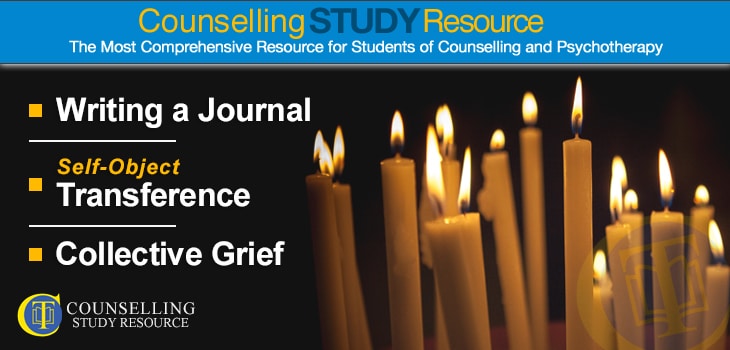053 – Writing a Journal – Self-Object Transference – Collective Grief
In episode 53 of the Counselling Tutor Podcast, Ken and Rory provide tips on journal-writing. ‘Theory with Rory’ looks at self-object and self-object transference (from the self-psychology movement). Finally, the presenters discuss the phenomenon of collective grief.
Writing a Journal (starts at 2.42 mins)
As counsellors, we offer clients empathy, sitting with them as they share their deepest emotions. To do this sensitively and safely, we need to have a good understanding of our own emotions. Writing a journal can help us with this process.
Ken and Rory share a number of key points on journaling:
- While the word ‘journal’ is often used in everyday language to describe a notebook where people write about what they do, in the counselling sense of the word it is a place to write about what you feel.
- Journaling can help you explore yourself, and find new vocabulary to describe your internal feelings.
- Some courses require you to keep a journal in a specific format and to submit it, while others ask you to do so for your own use only.
- If the journal is just for you, you can write it however you like, and not worry at all about spelling, handwriting etc.
- Trust yourself: let your journal be you, and feel free to put in it what you wish.
- Journals are an interesting record of our personal development, which can be interesting to look back on in future years.
- When you come to write assignments on personal development and self-awareness, your journal will be a rich source of material.
- Do make sure you keep your journal safe: be the keeper of your own confidentiality.
Rory has produced a video on different models of reflective writing.
Self-Object and Self-Object Transference (starts at 12.35 mins)
The self-psychology movement was popular in the US in the 1960s, led by Austrian-American psychoanalyst Heinz Kohut. His techniques were used in treating narcissistic personality disorder.
‘Self-object transference’ refers to the idea that an individual can introject by transference another person’s self-regulation and emotional stability – and then use this to self-soothe at times when that other person is not available. Rory talks to Bob Cooke of the Manchester Institute for Psychotherapy about this concept.
Bob explains self-object transference, which comes from the object relations movement. He describes how infants start to separate from their primary caregiver during the separation-individuation phase of development. During this, they internalise the mother; this then provides consistency over time, particularly when they are under stress. However, negative self-objects as well as positive ones can be internalised; these then have a negative effect on the youngster.
This idea can be extended to the client–therapist relationship: clients can learn to self-regulate and self-heal by being in the company of someone who is emotionally stable and grounded. This can also be referred to as therapist ‘modelling’ – an idea that appears too in Petruska Clarkson’s five-relationship model, where it is known as ‘reparenting’.
Collective Grief (starts at 22.22 mins)
This topic is just part of two full-length lectures on grief delivered recently by Rory which you can watch here.
Ken and Rory reflect on various examples of collective grief in the UK – for example, the recent Manchester Arena bombing, the Brexit referendum last year, and (back in 1995) the death of Princess Diana.
Collective grief is a sociological phenomenon that is important to recognise. It is not unusual for collective grief to be used as a conduit for other (unresolved) grief. As a therapist, these are things to look out for. If a client is affected by a collective grief that has not impacted you, do be thoughtful.


